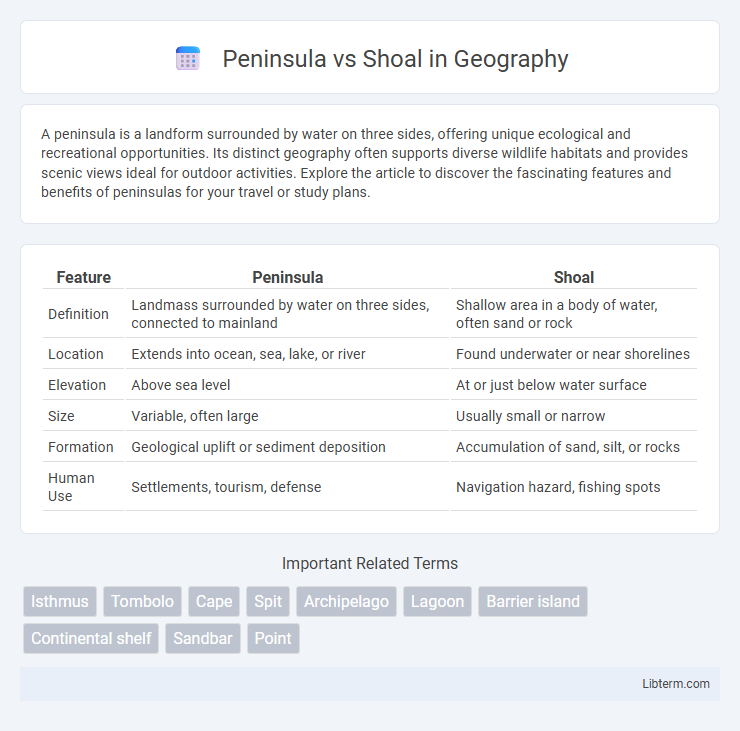A peninsula is a landform surrounded by water on three sides, offering unique ecological and recreational opportunities. Its distinct geography often supports diverse wildlife habitats and provides scenic views ideal for outdoor activities. Explore the article to discover the fascinating features and benefits of peninsulas for your travel or study plans.
Table of Comparison
| Feature | Peninsula | Shoal |
|---|---|---|
| Definition | Landmass surrounded by water on three sides, connected to mainland | Shallow area in a body of water, often sand or rock |
| Location | Extends into ocean, sea, lake, or river | Found underwater or near shorelines |
| Elevation | Above sea level | At or just below water surface |
| Size | Variable, often large | Usually small or narrow |
| Formation | Geological uplift or sediment deposition | Accumulation of sand, silt, or rocks |
| Human Use | Settlements, tourism, defense | Navigation hazard, fishing spots |
Defining Peninsula and Shoal
A peninsula is a landform surrounded by water on three sides while remaining connected to the mainland, often characterized by its extensive land area projecting into a body of water such as a sea or lake. In contrast, a shoal refers to a naturally submerged ridge, bank, or bar composed of sand, gravel, or other sediment that rises from the bed of a body of water, typically posing navigational hazards. The key distinction lies in the peninsula being a prominent terrestrial feature, whereas a shoal is primarily an underwater formation affecting water depth.
Key Geological Differences
A peninsula is a landform surrounded by water on three sides and connected to a mainland, often formed through tectonic plate movements or sediment deposition. A shoal is a shallow area in a body of water, typically composed of sand, silt, or gravel, created by sediment accumulation or erosion processes. Key geological differences include peninsulas being primarily terrestrial landforms extending into water, while shoals represent underwater or near-surface features that influence navigation and marine ecosystems.
Formation Processes
A peninsula forms through sediment deposition or tectonic activity that extends a landmass into a water body, often shaped by rising sea levels or erosion patterns. In contrast, a shoal is created by the accumulation of sand, gravel, or other sediments deposited by currents, waves, and tides, resulting in submerged ridges or shallow areas. Both landforms are influenced by dynamic interactions between geological structures and hydrodynamic forces, but peninsulas remain above water while shoals are typically underwater or just at the surface.
Location and Distribution
A peninsula is a landform extending into a body of water, surrounded by water on three sides, often found in coastal regions worldwide, such as the Iberian Peninsula in Europe and the Florida Peninsula in North America. Shoals are shallow marine features composed of sand or sediment, typically located near shorelines or river mouths, with notable examples including the Goodwin Sands in the English Channel and the Bahama Banks in the Atlantic Ocean. The geographic distribution of peninsulas tends to be larger and more prominent in global coastal topographies, whereas shoals are more localized and frequent in shallow water zones affecting navigation and marine ecosystems.
Ecological Significance
A peninsula, extending from the mainland into a body of water, creates diverse habitats by connecting terrestrial and aquatic ecosystems, supporting unique flora and fauna. Shoals, consisting of shallow areas formed by sand or rocks, serve as critical breeding and feeding grounds for marine species, enhancing biodiversity. Both landforms play vital roles in coastal protection, nutrient cycling, and sustaining fisheries by providing ecological niches and stabilizing shorelines.
Human Settlements and Usage
Peninsulas often host dense human settlements due to their strategic access to waterways, promoting trade and transportation. Shoals, characterized by shallow waters and sandy or rocky substrates, are less suitable for permanent habitation but can support fishing, marine navigation, and recreational activities. Coastal peninsulas typically feature developed infrastructure, while shoals serve as natural habitats and pose navigational hazards requiring careful mapping.
Impact on Navigation and Transportation
Peninsulas, extending land into bodies of water, often serve as natural landmarks and can create sheltered harbors that facilitate safe navigation and docking. Shoals, shallow areas or submerged ridges, pose significant hazards by reducing water depth and increasing the risk of grounding or collisions, necessitating careful charting and navigation aids. Both features influence shipping routes, with peninsulas sometimes redirecting traffic and shoals requiring avoidance to maintain safe and efficient transportation.
Popular Examples Worldwide
The Florida Peninsula in the United States is one of the most famous peninsulas globally, characterized by its extensive land protruding into the Atlantic Ocean and the Gulf of Mexico, supporting major cities like Miami and Tampa. Among prominent shoals, the Great Bahama Bank near the Bahamas is a notable example, consisting of shallow, sandy areas rich in marine biodiversity and coral reefs. These geographic features attract tourism, support unique ecosystems, and influence local climate and maritime navigation.
Role in Coastal Erosion and Deposition
A peninsula influences coastal erosion and deposition by altering wave energy and sediment transport, often causing sediment accumulation on its sheltered side while experiencing erosion on the exposed side. In contrast, a shoal, being a submerged or partially exposed sandbank, contributes to coastal deposition by trapping sediments and reducing wave energy before reaching the shore. Both landforms significantly affect local coastal morphology, but peninsulas primarily redirect energy flow, whereas shoals act as natural barriers promoting sediment buildup.
Choosing Between Peninsula and Shoal: Which is Which?
Peninsulas are landforms extending into a body of water, surrounded by water on three sides, while shoals are submerged or partially exposed sandbars or reefs posing hazards for navigation. When choosing between a peninsula and a shoal for activities like development or navigation, consider that peninsulas offer stable land suitable for building and recreation, whereas shoals require caution due to shallow waters and ecological sensitivity. Geographic data and water depth measurements are essential for distinguishing peninsulas from shoals, ensuring informed decisions based on physical characteristics and intended use.
Peninsula Infographic

 libterm.com
libterm.com